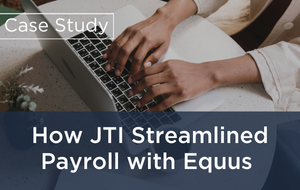Remote work has skyrocketed in popularity in the past year, and with many workers saying it is their preferred way to work, businesses need the tools to keep track of all these remote employees.
By Gareth Davies, VP Technology Solutions, Equus Software
Read the article on spiceworks.com
As remote work becomes the ‘new normal’, companies now have access to global talent pools, and workers have newfound freedom. This shift is permanent and growing, with a 2021 study from KPMG noting “25–30 percent of the workforce will be working from home by 2022.” Employees are demanding flexibility during interviews. In the war for talent, more and more employers are offering up this flexibility, with job advertisements commonly stating that the role can be performed ‘Remotely / WFH’. It’s a transformative change for businesses, especially mobility teams that need to serve the employees and also protect their employers from falling out of compliance.
Redefining “Home”
For HR and mobility teams, managing traditional assignment and business traveler programs tends to follow well-versed policies and practices to help the firm stay within compliance. The compliance risks for business travelers and assignees are broadly similar, including immigration, taxation and social security implications, as well as potential Posted Worker registrations, transfer pricing and permanent establishment considerations.
A consistent challenge for mobility teams is being able to track and analyze the vast volumes of trip records of potentially thousands of employees who might be traveling and then understand how to spot a compliance risk within that travel data. Business traveler technology available on the market does a good job with this task through data uploads or integration with travel booking software that can easily identify risk cases and, through workflow automation, support necessary compliance filings and reporting.
Businesses in 2022 and beyond must come to terms with the new ways of “working.” The pandemic made working from home a standard practice, not an exception. And it redefined what “home” means, as many people began working away from their main offices, whether to support their parents during lockdown or experience a more comfortable or accessible work environment while enjoying a stable job. When these employees shift across state or international borders, the same compliance risks that exist for business travelers will apply to these remote workers. This puts considerable strain on HR teams to manage these risks with outdated and manual processes that don’t always align with changing country-by-country regulations.
The only way firms can cope with this expansive, distributed and mobile workforce is through technology platforms and solutions. They need technology that adds efficiency to tracking and managing global teams and data integration ecosystems with their internal systems to support efficient reporting or filing obligations.
Moving Past Manual Processes
There’s currently a slow adoption rate for remote worker management software. Businesses have tried to use their HRIS systems to capture employees’ locations. This can be effective from a pure location tracking perspective, but they have no functionality to assess the cross-state/cross-border risks. By avoiding an advanced purpose-built solution, firms often have employees that are “out of sight, out of mind.” They’re out in the field, but the business doesn’t have visibility of their work activities and potential risks. With a dedicated remote worker technology application, these workers can receive needed support and attention, while the business can react with data-based decisions to help it ensure compliance.
New Technology Solutions Transform Mobility
Organizations managing remote work requests can now turn to new technology applications that can efficiently review risks and automate data collection. These applications can also approve or deny various requests based on acceptable thresholds or statuses, such as an employee holding the right to work in their chosen remote location. Such solutions provide firms with a comprehensive way to manage their global workforce, from business travelers to remote workers. It takes away many of the risks for HR, including missing filing deadlines or submitting incomplete applications. It uses automation to remind workers to submit their information in a timely manner and builds in deadlines and files paperwork before the worker travels.
A dynamic mobility solution will feature frequent country-by-country updates, which then create parameters for an employee’s actions, such as the duration of their stay and their specific actions when they’re in a new location. This prevents situations where HR needs to make guesses about the right process or policy. They can instead act with context and confidence and allow the organization to continue to reap the retention, cultural, and branding benefits of a globally connected and happy workforce.
For 2022 and beyond, the mobility “rulebook” is out the window. The new rules require nimbleness that’s possible with connected and reliable technology solutions. It’s essential for mobility teams to act proactively and manage staff who might spend six months remotely in Bangalore, eight in Boston, and then a year in the Dublin headquarters. Each location and work situation requires an understanding of local regulations, the person’s role, and other key factors that can influence risk outcomes. Manually managing this dynamic for 1,000 newly “untethered” employees is an unreasonable ask for compliance teams. They need technology solutions that automate consistent and data-driven policies that help a business excel in the global economy.





